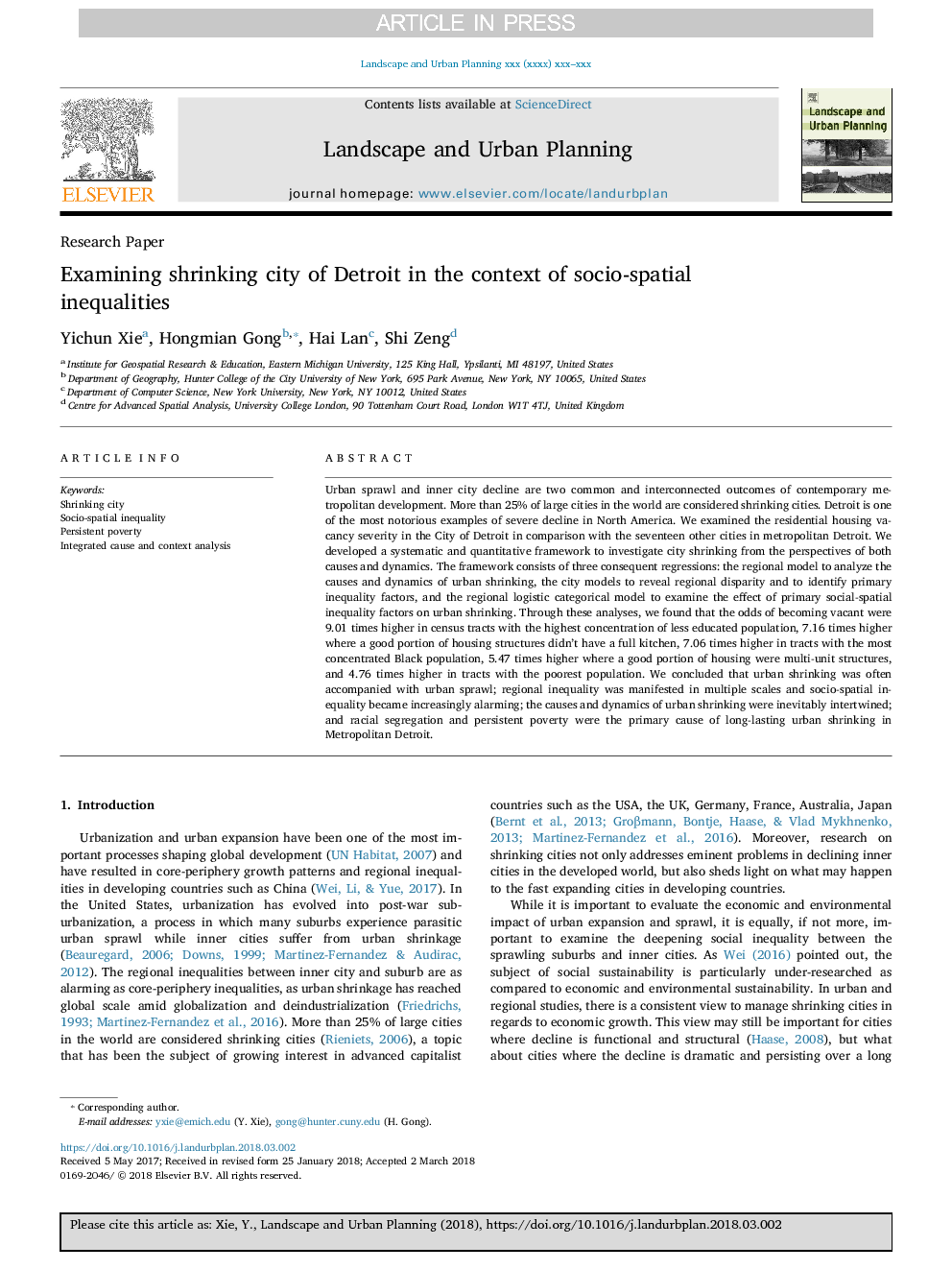ترجمه فارسی عنوان مقاله
بررسی شهر کوچک دیترویت در زمینه نابرابری اجتماعی و فضایی
عنوان انگلیسی
Examining shrinking city of Detroit in the context of socio-spatial inequalities
| کد مقاله | سال انتشار | تعداد صفحات مقاله انگلیسی |
|---|---|---|
| 153871 | 2018 | 12 صفحه PDF |
منبع

Publisher : Elsevier - Science Direct (الزویر - ساینس دایرکت)
Journal : Landscape and Urban Planning, Available online 24 March 2018
ترجمه کلمات کلیدی
کاهش شهر، نابرابری اجتماعی و فضایی، فقر پایدار، تجزیه و تحلیل علل و زمینه یکپارچه،
کلمات کلیدی انگلیسی
Shrinking city; Socio-spatial inequality; Persistent poverty; Integrated cause and context analysis;
ترجمه چکیده
فرسایش شهری و کاهش شهری داخلی، دو پیامدهای مشترک و متقابل توسعه کلان شهری هستند. بیش از 25 درصد از شهرهای بزرگ دنیا، شهرهای کوچک را در نظر می گیرند. دیترویت یکی از بدترین نمونه هایی از کاهش شدید در آمریکای شمالی است. ما در شهر دیترویت، در مقایسه با هفده شهر دیگر در شهر دیترویت، میزان خشونت مسکونی را در شهر دیترویت بررسی کردیم. ما یک چارچوب سیستماتیک و کمی را برای بررسی شهر کوچک از دیدگاه هر دو علت و دینامیک توسعه دادیم. چارچوب شامل سه رگرسیون پیچیده است: مدل منطقه ای برای تجزیه و تحلیل علل و پویایی کاهش شهری، مدل های شهری برای نشان دادن اختلافات منطقهای و شناسایی عوامل نابرابری اولیه و مدل منطقهای منطقهای منطقهای برای بررسی تأثیر اولیه روابط اجتماعی-فضایی عوامل نابرابری در کاهش شهری. از طریق این تحلیل ها، دریافتیم که شانس خالی شدن در 901 برابر بیشتر در بخش های سرشماری با بالاترین میزان تمرکز جمعیت کمتر تحصیلکرده، یعنی 7.16 برابر بیشتر است، در حالیکه بخش قابل توجهی از ساختارهای مسکونی در آن وجود دارد، یک آشپزخانه کامل، در 7.06 برابر بیشترین تراکم جمعیت سیاه، 5.47 برابر بیشتر از جایی که بخش خوبی از مسکن ساختارهای چندگانه بود، و 4.76 برابر بیشتر در مناطق با فقیرترین جمعیت بود. ما نتیجه گرفتیم که کاهش شهرها اغلب با گسترش شهرها همراه است؛ نابرابری منطقه ای در مقیاس های متعدد ظاهر شد و نابرابری اجتماعی و فضایی به طور فزاینده هشدار دهنده شد؛ علل و پویایی کاهش جمعیت شهری ناگزیر در هم تنیده بودند؛ و جدایی نژادی و فقر مستمر علت اصلی کاهش طولانی مدت شهری در شهر دیترویت بود.

